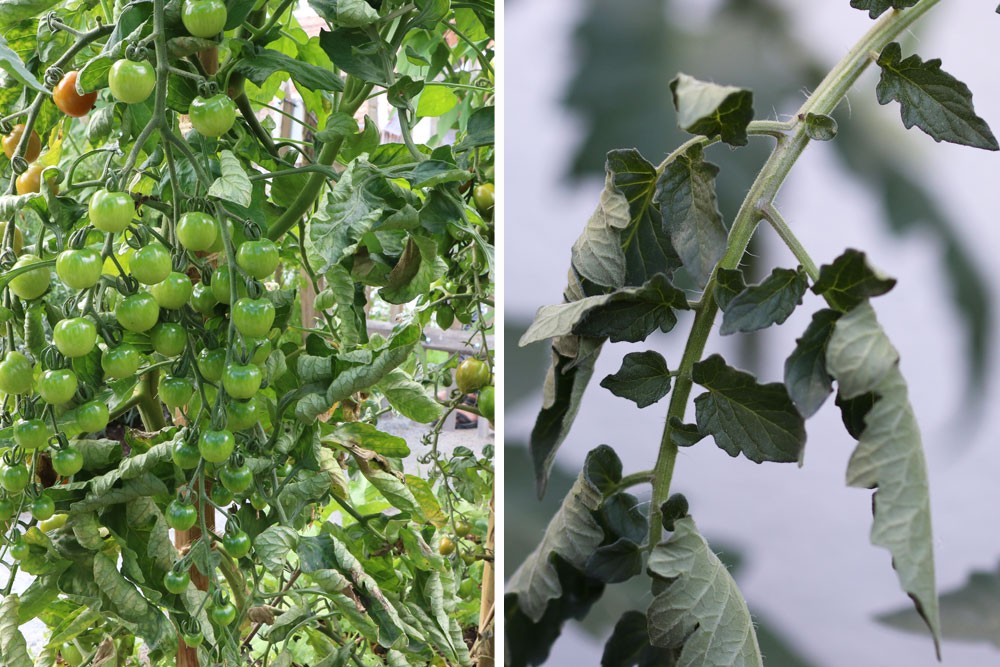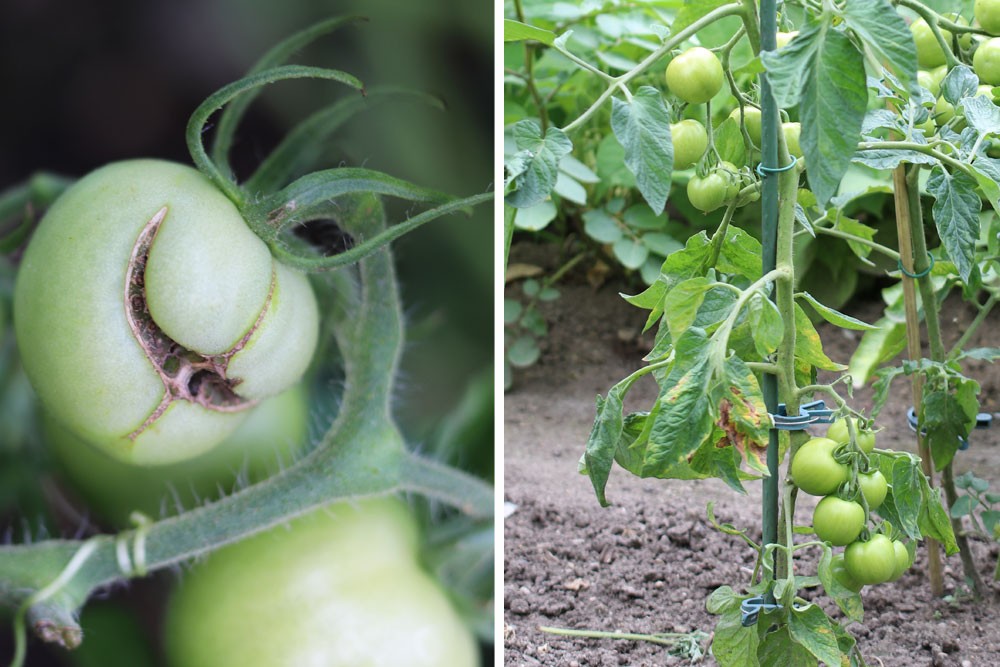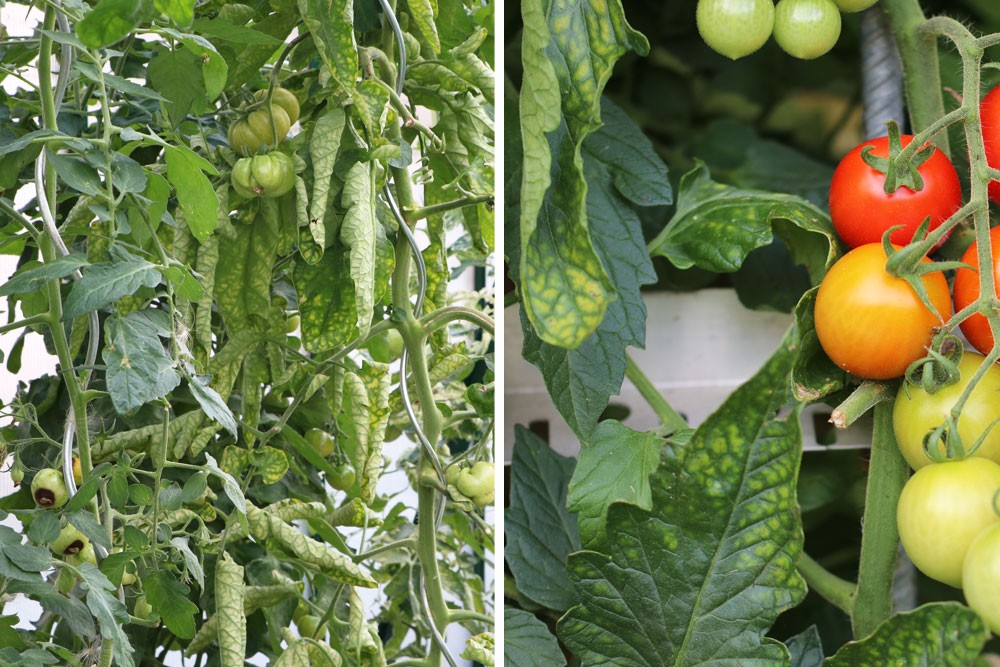You are already looking forward to growing and enjoying your own tomatoes, but suddenly the tender plants droop their leaves and look limp? Don’t worry, it’s not too late. We’ll explain the causes behind droopy leaves and what you can do about it. With our tips, your tomato plants will soon look healthy and strong.
Contents
Leaves are floppy
Why do the leaves hang down limply?
Droopy foliage signals that the plant has been improperly cared for. This may be a basic lack of care, for example, due to ignorance. Another possibility is a sudden change in environmental or weather conditions that was not responded to quickly enough or sufficiently. Incorrect repotting may also be a contributing factor. Depending on the tomato and how it is grown, there are different causes.

Outdoor tomatoes with limp leaves.
Tomato plants that have their foliage drooping limply in the open field are suffering from an acute lack of water. It is best to water the plants immediately to quench the greatest thirst. You can achieve a long-term healthy water balance with the following tips.
Water tomatoes properly
The tomato plant prefers a constant water supply. This refers to both the amount of water and the time of day you water. In addition, the watering method is crucial. As nice as it would be, there is no set watering schedule, as it all depends on the weather. The following watering tips will give you some direction. However, always include the temperatures, the intensity of the sun and the wind.
- water thoroughly in the first 3 days after planting
- after that, give 0.5 l of water per tomato plant every day
- after fruit set, the tomato plant needs 150 to 300 ml per fruit
Important: Always water evenly and directly to the ground. Too much water, as well as wet leaves and damp flowers tomatoes do not like at all. With a mulch layer of nettles or straw you prevent too much splashing when watering. Avoid too much water in too short a time and waterlogging. Once waterlogging has occurred, repotting is advisable.
Tomatoes in the greenhouse
Tomatoes in a greenhouse with limp foliage
With tomato plants in a greenhouse, droopy foliage is rarely due to a lack of water, as a regular water supply is usually guaranteed under the sheltered conditions. If your greenhouse tomatoes still hang their heads, it is due to improper ventilation.

Proper ventilation
The greenhouse should be located in a place where there is a balance of sun and wind. It should be well ventilated by a light wind, but not exposed to extreme winds. The wind should be at least somewhat broken at this point.
The main source of energy for the tomato plant is the sun. Through it, the tomato can ideally utilize all the nutrients. On the one hand, warm sunny days are a boon for the plant, but on the other hand, it is precisely then that adequate ventilation is required.
Open the side windows of your greenhouse. This will allow the air to circulate better and reach the tomato plant. On very hot days with many hours of sunshine, for which there are no severe weather warnings, it is best to leave your greenhouse completely open.
Limp tomato leaves, yellowing
A leaf that droops limply and at the same time shows yellowing is suffering from a nutrient deficiency. Tomato is a heavy grower, which means that it needs a lot of nutrients for its growth. Therefore, the plants should be fertilized during the growth and ripening process. A tomato plant needs these amounts of nutrients to ripen 1 kg of tomatoes per square kilometer.
- 3 g nitrogen
- 0.5 g phosphate
- 3.8 g potassium
- 4 g magnesium
In addition, sulfur and trace elements such as manganese, boron and iron are useful in a balanced ratio. You can either put together this nutrient cocktail yourself or use a ready-made tomato fertilizer. In this all nutrients are contained in the right amount.
These variants are available:
- Liquid fertilizer
- Fertilizer sticks
- Drops

For tomato plants in the bed, you should enrich the soil with a good fertilizer in the fall. At planting time next year, the soil then already contains many of the important nutrients. Once the tomatoes are planted out, they will need regular new fertilizer. For tomato cultivation in containers, a mineral slow-release fertilizer is best suited to provide the basic supply.
Important: When repotting, do not fertilize too much at once. Overfertilizing will result in excessive salt content and curling of the tomato leaves. Regular fertilizing in moderate amounts is correct. Avoid one-sided fertilizing with only some of the nutrients. This will make tomato plants susceptible to fungi and pests. In addition, blossom end rot can develop. Since the nutrients also influence each other and partially neutralize each other, the correct dosage is particularly important.
Pest infestation
Another reason for droopy tomato leaves: pests.
If your tomato’s foliage is drooping, you should also always check to see if it’s infested with pests. Typical pests such as “thrips” or the “whitefly” often target tomato plants. Here’s what you can do about them.
Whitefly – Trialeurodes vaporariorum
They are 2 mm small insects that look like white powdered. They cavort on the undersides of the leaves. In the open field, a close-meshed net helps to protect against infestation. In your greenhouse, releasing beneficial insects such as ichneumon flies and ladybugs is a proven solution.
Thrips or fringe winged beetles – Thysanoptera.
Fringe winged insects are tiny, black insects. They leave mottling on tomato leaves and fruit. Blue glue boards are recommended for prevention. To treat an infestation, it is best to use beneficial insects such as lacewing larvae, predatory mites or hoverflies. Additionally, spraying garlic tea or soft soap solution will help.










